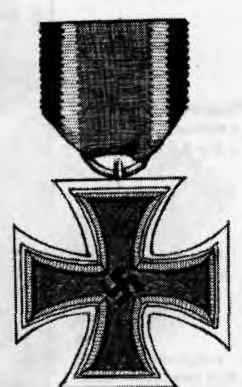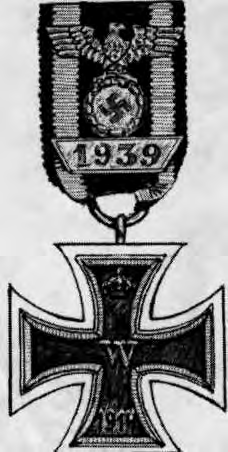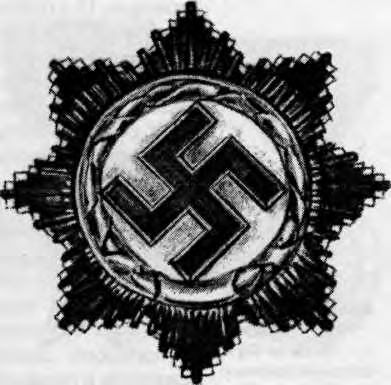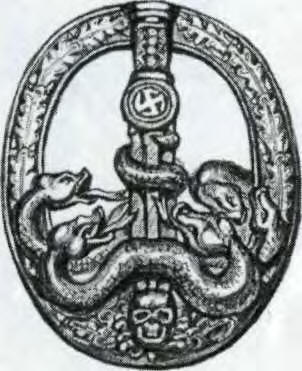
Iron Cross 2nd class, model 1939

Online collections
monedastodas.com
All collections » Awards » German Third Reich
The order was established on March 1, 1813 by the King of
Prussia, Frederick William III, to reward those who distinguished themselves
during the wars with Napoleon. Participants were subsequently awarded
Franco-Prussian (1870-1871) and World War 1 (1914-1918) wars. Restored again on
September 1, 1939.
According to its statute, it was initially divided into two degrees: the Iron
Cross and the Knightly Cross.
cross of the Iron Cross, by the end of the war there were already eight degrees:
Iron Cross 2-th degree; Iron Cross 1st class; Knight's Cross; Knight's cross
with oak leaves; Knight's cross with oak leaves and swords; Knight's Cross with
Oak Leaves, Swords and Diamonds; Knight's Cross with golden oak leaves, swords
and diamonds; Grand Cross of the Iron Cross.
Persons who were awarded one of the degrees of the order during the 1st World
War and who earned it a second time during the 2nd World War were awarded a
special badge. The order was awarded to military personnel who showed particular
courage in battle or outstanding achievements in command of troops. Both German
military personnel and foreign citizens could be awarded. The next degree was
awarded only if there was a lower one.
The 2nd and 1st degrees of the Iron Cross were awarded to senior officers armed
forces in a position not lower than division commander. The Knight's Cross and
its higher degrees could only be awarded by the Supreme Commander-in-Chief.
Externally identical to the cross of the 2nd degree. Fastening - pin, rarely screw. The number of recipients is about 300,000 people.

Iron Cross 2nd class, model 1939

Iron Cross, 2nd class, model 1914, with a sign of re-awarding the order of the
same class, model 1939.
The badge was a silver metal imperial eagle with a bar and the inscription "1939". Attached with a pin to the black and white ribbon of the Iron Cross 2nd class (2nd class), or higher than the Iron Cross 1st class (1st class).
Identical to the Iron Cross, but slightly larger. The edges
are edged with silver. Size - 48x49 mm. Worn
on the neck on a red-white-black ribbon 45 mm wide. The number of awardees is
7,358 people, including 41 foreigners. Many German soldiers, afraid of losing
the Knight's Cross, wore the Iron Cross, 2nd degree, on a ribbon instead.
Established on June 3, 1940. A bunch of three silver oak leaves (20 mm high) was attached to the ribbon of the Knight's Cross. The number of awardees is 890 people, including 8 foreigners.
Established September 28, 1941
Crossed silver swords, 24 mm long, were attached under the leaves. The number of
awardees is 160 people, including 1 foreigner.
Established on September 28, 1941, 50 small diamonds with a total weight of no
more than 2.7 carats were placed on oak leaves and sword hilts. The number of
awardees is 27 people.

Established December 29, 1944
Golden oak leaves were made from low-grade gold. Number of recipients: 1 person
(January 1, 1945, commander of the 2nd dive bomber squadron, Colonel Rudel, who
flew 2,530 sorties and destroyed more than 500 enemy tanks).
Similar to the Knight's Cross, but larger, edges edged in
gold. Size 63x71 mm. A golden eight-pointed star with the sign of the order in
the center was attached to the neck cross. Worn on
neck on a tape 57 mm wide. Number of recipients: 1 person (July 19, 1940,
Reichsmarshal Goering).
The Order was established on September 28, 1941. According to
its statute, it had three degrees: Silver German Cross; Golden German Cross;
Diamond German Cross. (This degree was never produced).
In terms of importance, the Order of the German Cross was between the Iron Cross
of the 1st degree and the Knight's Cross; awarded only for military merit.
The Silver German Cross was awarded to military personnel who had already been
awarded the Military Merit Cross 1st Class with swords, but whose actions were
insufficient to receive the Knight's Cross of the Military Merit Cross. The
Golden German Cross was awarded to military personnel who had already been
awarded the Iron Cross 1st class, but whose actions were insufficient to receive
the Knight's Cross.
When awarding a higher degree of the order, the lower one was not worn.

An eight-pointed metal star, covered in black enamel, with
silver or gilded edges. In the center - a black swastika on a white background,
framed by a wreath of laurel leaves.
At the bottom of the wreath are the numbers “1941”. For the Silver German Cross
the wreath was covered with silver, for the Gold Cross - with gold.
There were also mechanically embroidered samples of both degrees.
Fastening - pin or thread, respectively.
Established on October 18, 1939 to reward military personnel
whose merits were insufficient to be awarded the Order of the Iron Cross or the
German Cross, but still sufficient to reward them with another award. According
to the statute, there were five degrees of the order: Medal of the Cross of
Military Merit; Military Merit Cross, 2nd class; Military Merit Cross, 1st
class; Knight's Cross; Golden Knight's Cross.
The Order of the Cross of Military Merit could be issued without swords or with
swords. The option without swords was complained of as a reward for military
merits not related to combat operations, but performed in combat conditions.
The option with swords was complained about for successful actions on the
battlefield, but it could also be granted to industrialists and inventors
working in the military sphere. If there was an order with swords, the junior
degree was not worn without swords.
All degrees of the order were awarded in ascending order, however, when a
serviceman was immediately awarded the Cross of Military Merit of the 1st
degree, the 2nd degree was issued automatically. Awards were made four times a
year: January 30, April 20, May 1 and September 1. The right to be awarded was:
the medal of the Cross of Military Merit and the Cross of Military Merit, 2nd
degree - commanders of military units from the division commander inclusive;
Cross of Military Merit, 1st degree - commanders-in-chief of the armed forces;
Knight's Cross and Golden Knight's Cross - only Reich Chancellor.
The award could be received by both military personnel and civilians. The
youngest of the recipients was 10 years old (1943, Cross of Military Merit, 2nd
class with swords), and the oldest was 78 years old!
If there was a 1st degree of the order, the 2nd was not worn, and its presence
was confirmed by a ribbon worn similarly to the ribbon of the Iron Cross of the
2nd degree, and when worn together, the ribbon of the senior award overlapped
diagonally.

Established on August 19, 1940. On the front side is the Cross of Military Merit without swords, on the back is the inscription “For Military Merit. 1939". Worn on a black, white and red ribbon 30 mm wide, which differed from the ribbon of the 2nd degree order by a narrow red stripe in the center. The medal was made of bronze.

A Maltese cross, on the front side of which there was a
swastika in the center, framed by an oak wreath. On the reverse side are the
numbers “1939”. Size 48x48 mm. Worn on a black and red white ribbon 30 mm wide.
Until the spring of 1942, the order was made of bronze, and later - of zinc.
Number of recipients: 2,700,000 people

Identical to the 2nd degree cross. Fastening - pin or screw. It was made of silver, by the end of the war - from a silver alloy. The number of awardees is 140,000 people.

Knight's Cross of the Military Merit Cross with Swords
Established on September 28, 1941. Identical to the 1st degree cross, but slightly larger. On the reverse side are the numbers “1939”. Size 52x58 mm, made of silver. Worn on a black, white and red ribbon 45 mm wide. The number of recipients was 230 people (including 52 with the Order without Swords).
Established on July 8, 1944. Identical to the Knight's Cross. Made from gilded silver. Number of recipients - 2 people - Franz Hane and Karl Saur (both - April 20, 1945).
Established on July 14, 1942 to reward
military personnel from the eastern nations who performed feats,
i.e. for personnel of the Russian Liberation Army (ROA),
Ukrainian Insurgent Army (UPA), Cossack units, Turkestan
battalions, local police battalions and law enforcement
services, etc. In addition, it could also be awarded to Germans
- military personnel of these units. In terms of significance,
the award was equal to the Order of the Iron Cross and the Cross
of Military Merit. According to the statute, there were two
types of order: with swords (“For Bravery”), and without swords
(“For Merit”) and five degrees: order of the 2nd degree
(bronze); Order of the 2nd degree (silver plated); Order of the
2nd degree (gilded); Order of the 1st degree (silver plated)
Order of the 1st degree (gilded). The Order of Bravery, 2nd
degree (silver plated) was equivalent to the Iron Order
cross of the 2nd degree, and “For bravery” of the 1st degree
(silver plated) - the Iron Cross of the 1st degree. The various
grades of the Order of Merit corresponded to the grades of the
Cross of Military Merit. The awards were made first with lower
degrees, then with higher ones. In case of exceptional merit, an
order of the highest degrees could be immediately awarded.
The right to award awards belonged to commanders of military
formations from the division commander inclusive and commanders
of individual units.
The Order of the 2nd class (bronze) was worn on a dark green
ribbon; order of the 2nd degree (silver plated) - on a green
ribbon with white stripes at the edges; Order of the 2nd degree
(gilded) - on a ribbon light green with red stripes at the
edges.
Orders of the 1st degree were attached to a pin.

Established on May 26, 1942 to reward participants in
defensive battles on the Eastern Front in the winter of 1941-42. Awarded to
military personnel who participated in hostilities in the period from November
15, 1941 to April 15, 1942 and took part directly in battles for at least 14
days (for Air Force personnel - in combat missions for 30 days). It was also
issued to military personnel who were wounded and already awarded the “For
Wound” badge; or for staying on a given section of the front at a specified time
continuously for for 60 days or more. The medal was also awarded to military
personnel of the allied states who fought in the same period on this sector of
the front as part of the German Armed Forces.
On the front side, under the convex image of a steel helmet and a hand grenade,
there was an imperial eagle and a laurel branch underneath. On the reverse side
there is a sword with a laurel branch and the inscription “WINTERSCHLACHT IM
OSTEN 1941-42”.
Worn on a red ribbon with thin white and black stripes in the middle. The ribbon
was threaded through a loop of the jacket and worn both independently and
partially covered by the ribbon of the Iron Cross, 2nd degree.

Established on August 2, 1939 to reward military personnel and
civilians involved in the construction of the Atlantic Wall defensive line.
Awards were made from the date of establishment of the medal to March 31, 1941
and were resumed from October 10, 1944 until the end of the war.
The obverse depicts a defensive structure, a crossed dagger and spade, and an
imperial eagle. The entire group of elements is placed in an oval, bordered by a
wreath of oak leaves. On the reverse side there is the inscription “FUR ARBEIT
ZUM SCHÜTZE DEUTSCHLANDS”.
Size 40x33 mm. Worn on a yellow-orange ribbon with
two narrow white stripes. Tape width – 26 or 31 mm. Until 1944, the medal was
made of bronze, and later - of zinc with a bronze coating.
Number of awarded – 622,064 people.

Established on December 20, 1939 to reward military personnel
of non-motorized infantry and mountain rifle units; from June 1, 1940, it was
also awarded to military personnel of machine gun and artillery units of
infantry and mountain rifle units. The badge could be obtained by a person who
participated in three attacks, or who participated in hostilities for at least
three days continuously. The concept of “attack” included both attacking and
counterattacking actions. Repeated participation in attacks resulted in the
awarding of the “Close Combat” badge, so higher degrees of the “Assault Badge”
were not established. The commanders of regiments and individual units had the
right to award the badge.
A silver-plated bronze wreath of oak leaves, superimposed with an image of a
rifle, with an Imperial eagle above it. For infantry personnel, the badge was
purely bronze. Size: 54x43 mm. Fastening - pin.

Established June 1, 1940
The “For Attack” badge was awarded to military personnel of various units of the
ground forces for actions that contributed to the success of the attack and the
capture of enemy positions, if at the same time they served in units whose
personnel could not be awarded the “Assault Badge”.
Initially, the badge had one grade and was issued for participation in three
attacks on different days. On June 22, 1943, four more degrees were introduced:
a degree with the number “25” for 5-25 days of fighting; degree with the number
“50” for 25-50 days of fighting; degree with the number “75” for 50-75 days of
fighting; degree with the number “100” for 75-100 days of fighting.
When awarding badges of several degrees, only the highest was worn.
Awards were made by commanders of military units and units, up to and including
the division commander.
Size 54x43 mm. A silver-plated bronze wreath of oak leaves, in the center of
which were images of the imperial eagle and a crossed bayonet and hand grenade.
The numbers “25”, “50”, “75”, “100” on the signs were gilded, and the last
degrees had a gilded wreath. The last two degrees were externally different from
the first. Fastening - pin.

There were two versions of the sign (for the ground forces and
for the air force), differing in appearance only in the type of imperial eagle.
The ground forces version was established on November 5, 1942, the air force
version on November 3, 1944.
The badge was awarded to participants in hand-to-hand combat, and the days on
which hand-to-hand clashes with the enemy took place were counted for the award.
For military personnel who fought on the Eastern Front or in the African Theater
of Operations from June 22, 1941 or March 26, 1943, respectively, an award rule
was introduced under which the deadline:
from 8 to 12 calendar months was equivalent to 5 days of fighting;
from 12 to 15 calendar months was equal to 10 days;
over 15 calendar months was equivalent to 15 days.
For air force personnel, the same rule was introduced on January 1, 1944.
According to the statute, the badge had three degrees:
3rd degree (bronze) - for 15 days of fighting;
2nd degree (silver plated) - for 30 days of fighting;
1st degree (gold plated) - for 50 days of fighting.
If there was a higher degree, the lower one was not worn.
Badges were also awarded as an incentive to the seriously wounded, at the rate
of 10 days of fighting for the 3rd degree, 20 days of fighting for the 2nd
degree and 40 days of fighting for the 1st degree; from August 1944 this rule
was abolished.
Air Force personnel who had previously received the army version replaced it
with a similar air force badge.
A bronze, later zinc, oak leaf bundle, in the center of which was a crossed hand
grenade and bayonet, and above them an Imperial (Air Force eagle) and swastika.
Size 97x27 mm. Fastening - pin. Number of recipients: 403 people (1st degree).

Badge "For Tank Battle" 5th class
Established on December 20, 1939 for the ground forces and on
November 3
1944 - for the air force (airfield divisions). According to the statute, one
degree of the badge was awarded, awarded for three days of fighting, but on June
22, 1943, four more degrees were introduced: 4th degree - for 25 days of
fighting; 3rd degree - for 50 days of fighting; 2nd degree - for 75 days of
fighting; 1st degree - for 100 or more days of fighting.
The badge was intended to reward members of tank crews, and from June 1, 1940,
it was also awarded to all other members of the armored forces. Tank crews
received silver plated badges, while the rest received bronze ones.
The countdown of days of fighting began on July 1, 1943, but for those who
fought on the Eastern Front and the African theater of operations,
past battles: from 8 to 12 calendar months were equivalent to 10 days of
battles; from 12 to 15 calendar months were equal to 18 days; over 15 calendar
months were equal to 25 days.
For the seriously wounded, the 4th degree of the badge was issued 18 days in
advance.
fighting, 3rd degree - for 35 days of fighting, 2nd degree - for 60 days of
fighting.
If there were several degrees, the highest was worn.

Badge "For Tank Battle" 4th class
Bronze wreath of oak leaves depicting a PzKpfw IV tank, and above it - the Imperial Eagle (Air Force Eagle). Size 60 x42 mm. The numbers are gold plated. The signs of higher and lower degrees differed somewhat in design. Fastening - pin.

Established September 1, 1939
According to the statute, it was divided into three degrees:
3rd degree (blackened) - for 1-2 wounds;
2nd degree (silver plated) - 3-4 wounds;
1st degree (gold plated) - four or more wounds or disability.
The badge was received by military personnel who were wounded or damaged both in
occupied territory and within Germany. Civilians who suffered from enemy air
raids were also awarded. From September 24, 1944, foreign military personnel of
the German Armed Forces could also receive the badge.
Injuries included loss of vision or hearing, frostbite, loss or impairment of
limb function, traumatic brain injury, and non-healing wounds. Several injuries
received at the same time were considered as one.
Different numbers or combinations of wounds gave different degrees of the sign.
Unit commanders from the battalion commander inclusive, senior officials had the
right to present the badge
medical institutions and heads of civil defense districts.
There was also a version of the badge “For wounding on July 20, 1944”, awarded
to victims of the explosion in the bunker in Rustenburg.
This sign was additionally marked with the date and signature of A. Hitler. The
sign had three degrees.
A bronze oval bordered with oak leaves, inside which a steel M35 helmet is
placed on crossed swords.
Size 37x44 mm. Fastening - pin.

Anti-aircraft artillery badge, ground forces version
Established on January 10, 1941 in the Air Force and on April
18, 1941 in the Ground Forces.
The badge was issued to personnel and support personnel of anti-aircraft
artillery units of the German air force and ground forces. Before the
introduction of a similar badge in the ground forces, it was also awarded to
anti-aircraft gun crews for the destruction of enemy ground targets.
Badges were awarded to the platoon commander, commander and crew members of the
anti-aircraft gun after the destruction of the fifth enemy aircraft. Commanders
of anti-aircraft artillery companies or batteries could receive this distinction
if more than half of the crews subordinate to them had already been awarded this
badge. Commanders of anti-aircraft artillery units were awarded similarly: at
least half of the officers subordinate to them were required to have a badge.
A silver-gray oval of oak leaves overlaid with images of an
88mm anti-aircraft gun and an Imperial (Air Force) eagle. Size 57x44 mm.
Fastening - pin.

Sign "Skydiver" ground forces
Established on September 1, 1937. The badge was received by
all military personnel of the airborne units of the German army who received
parachute training.
The badge was awarded until the airborne units were transferred to the Air
Force. After this, all paratroopers began to receive a version of the Air Force
Parachutist badge, which was established on November 5, 1936.
A gilded bronze wreath made of oak leaves, inside of which was a silver-plated
diving eagle. Above it is a small gilded imperial eagle.
The Air Force version was a bronze wreath of oak and laurel leaves, inside of
which was a gilded diving eagle with a swastika in its talons. Size 55x42 mm.
Fastening - pin.

Established on January 30, 1944 for military personnel of SS
and police units who distinguished themselves in the fight against partisans.
Subsequently, they were also awarded to military personnel of the ground forces
and personnel of auxiliary units participating in the counterinsurgency fight.
According to the statute, he had three degrees: 3rd degree (bronze) - for 20
days of fighting; 2nd degree (silver plated) - for 50 days of fighting; 1st
degree (gold plated) - for 100 days of fighting.
The badge could be presented by senior commanders of the SS and police forces,
as well as commanders of units of the German army. The 1st degree was awarded
directly by SS Reichsführer G. Himmler.
A bronze wreath of oak leaves, on which was placed a sword, immersed with its
tip in a ball of poisonous snakes.
Dimensions 58x50 mm. Fastening - pin.